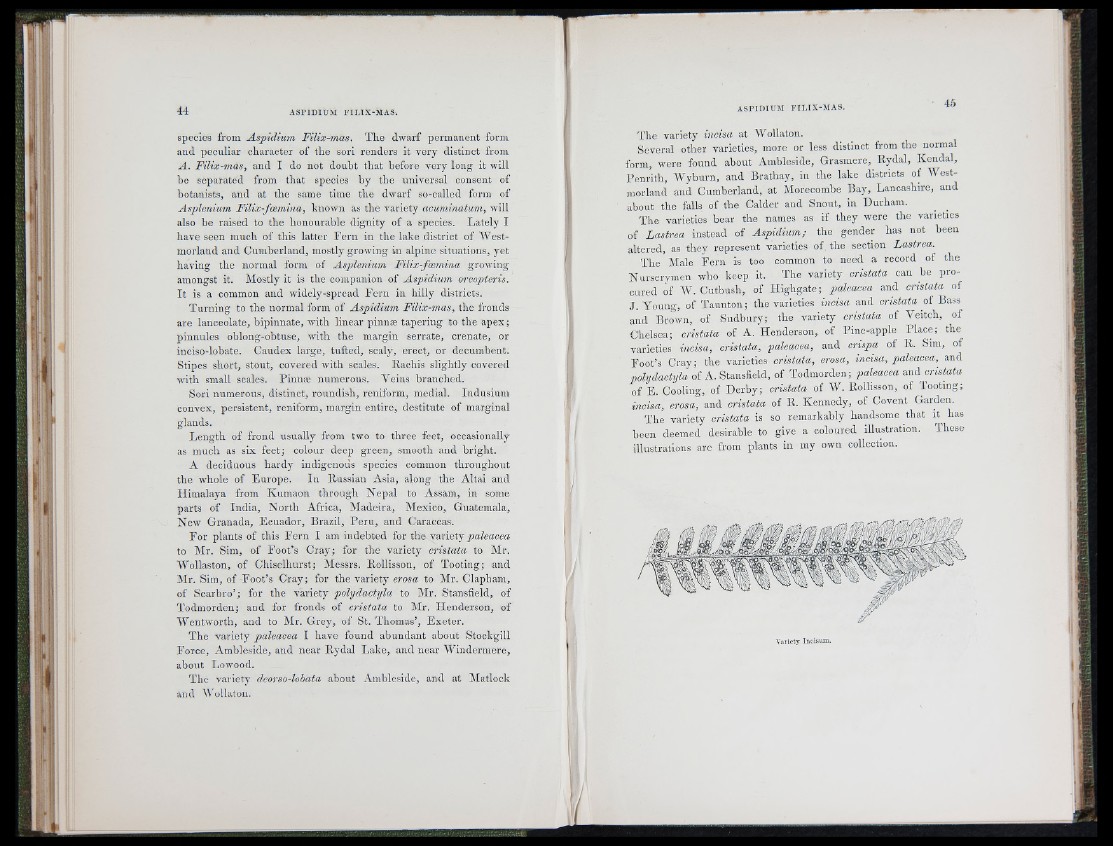
44 A S P ID IU M I 'lL lX -M A S .
species from Aspidiutn Filix-mas. The dwarf permanent form
and peculiar character of the sori renders it very distinct from
A . Filix-mas, and I do not doubt that before very long it will
be separated from that species by the universal consent of
botanists, and at the same time the dwarf so-called form of
Asplenium Filix-fcemina, known as the variety acuminatum, will
also be raised to the honourable dignity of a species. Lately I
have seen much of this latter Fern in the lake district of Westmorland
and Cumberland, mostly growing in alpine situations, yet
having the normal form of Asplenium Filix-foemina growing
amongst it. Mostly it is the companion of Aspidium oreopteris.
I t is a common and widely-spread Fern in hilly districts.
Turning to the normal form of Aspidium Filix-mas, the fronds
are lanceolate, bipinnate, with linear pinnæ tapering to the apex;
pinnules oblong-obtuse, with the margin serrate, crenate, or
inciso-lobate. Caudex large, tufted, scaly, erect, or decumbent.
Stipes short, stout, covered with sc.ales. Hachis slightly covered
with small scales. Pinnæ numerous. Veins branched.
Sori numerous, distinct, roundish, reniform, medial. Indusium
convex, persistent, reniform, margin entire, destitute of marginal
glands.
Length of frond usually from two to three feet, occasionally
as much as six feet; colour deep green, smooth and bright.
A deciduous hardy indigenous species common throughout
the whole of Europe. In Russian Asia, along the Altai and
Himalaya from Kumaon through Nepal to Assam, in some
parts of India, N orth Africa, Madeira, Mexico, Guatemala,
New Granada, Ecuador, Brazil, Pe ru , and Caraccas.
For plants of this Fern I am indebted for the YAxietj paleacea
to Mr. Sim, of Foot’s Cray; for the variety cristata to Mr.
Wollaston, of Chiselhurst; Messrs. Eollisson, of Tooting; and
Mr. Sim, of Foot’s Cray; for the variety erosa to Mr. Clapham,
of Scarbro’; for the variety pohjdactijla to Mr. Stansfield, of
Todmorden; and for fronds of cristata to Mr. Henderson, of
Wentworth, and to Mr. Grey, of St. Thomas’, Exeter.
The variety paleacea I have found abundant about Stockgill
Force, Ambleside, and near Rydal Lake, and near Windermere,
about Lowood.
The variety deorso-lohata about Ambleside, and at (Matlock
and I\ ollaton.
A S P ID IU M P IL IX -M A S . 4.5
The variety incisa at Wollaton.
Several other varieties, more or loss distinct irom the normal
form, were found about Ambleside, Grasmere, Rydal, Kendal,
Rcnrith, Wyburn, and Brathay, in the lake districts of Westmorland
anil Cumberland, at Morecombe Bay, Lancasbire, and
about the falls of the Calder and Snout, in Durham.
The varieties bear the names as if they were the varieties
of Lastrea instead of A spidium ; the gender has not been
altered, as they represent varieties of the section Lastrea.
The Male Eern is too common to need a record of the
Nurserymen who keep it. The variety cristata can be procured
of W. Cutbush, of Highgate; paleacea and cristata of
J. Young, of Taunton; the varieties incisa and cristata oi Bass
and Brown, of Sudbury; the variety cristata of Veitch, of
Chelsea; cristata of A. Henderson, of Pine-apple Place; the
varieties incisa, cristata, paleacea, and crispa of R. Sim, of
Foot’s Cray; the varieties cristata, erosa, incisa, paleacea,^ and
polydactijla of A. Stansfield, of Todmorden; paleacea AnA cristata
of E. Cooling, of Derby; cristata of W. Rollisson, of Tooting;
incisa, erosa, and cristata of R. Kennedy, of Covent Garden.
The variety cristata is so remarkably handsome that U has
been deemed desirable to give a coloured illustration. These
illustrations are from plants in my own collection.